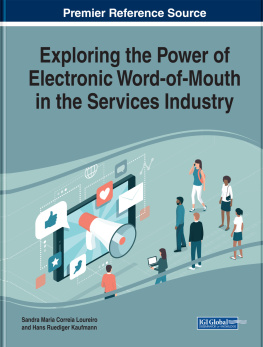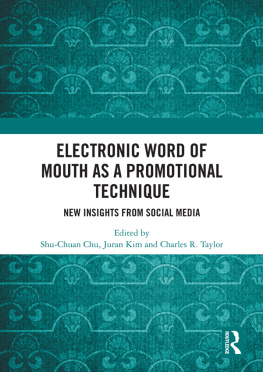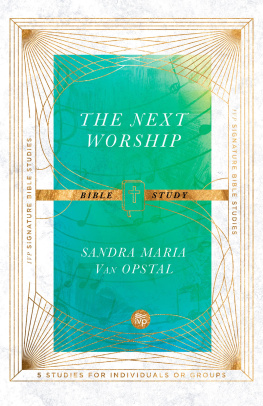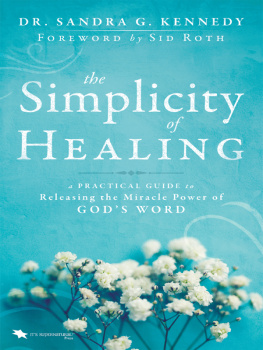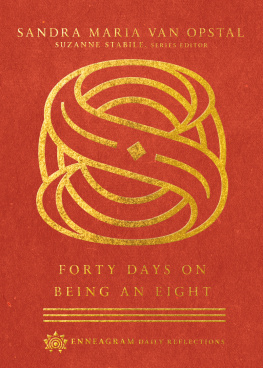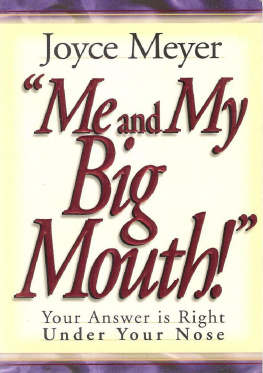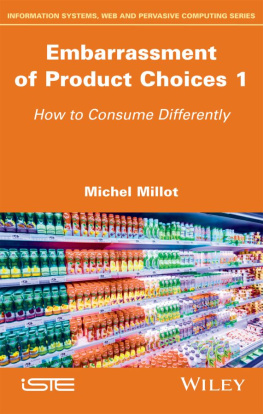Sandra Maria Correia Loureiro - Exploring the Power of Electronic Word-of-Mouth in the Services Industry
Here you can read online Sandra Maria Correia Loureiro - Exploring the Power of Electronic Word-of-Mouth in the Services Industry full text of the book (entire story) in english for free. Download pdf and epub, get meaning, cover and reviews about this ebook. year: 2020, publisher: IGI Global, genre: Business. Description of the work, (preface) as well as reviews are available. Best literature library LitArk.com created for fans of good reading and offers a wide selection of genres:
Romance novel
Science fiction
Adventure
Detective
Science
History
Home and family
Prose
Art
Politics
Computer
Non-fiction
Religion
Business
Children
Humor
Choose a favorite category and find really read worthwhile books. Enjoy immersion in the world of imagination, feel the emotions of the characters or learn something new for yourself, make an fascinating discovery.
- Book:Exploring the Power of Electronic Word-of-Mouth in the Services Industry
- Author:
- Publisher:IGI Global
- Genre:
- Year:2020
- Rating:4 / 5
- Favourites:Add to favourites
- Your mark:
- 80
- 1
- 2
- 3
- 4
- 5
Exploring the Power of Electronic Word-of-Mouth in the Services Industry: summary, description and annotation
We offer to read an annotation, description, summary or preface (depends on what the author of the book "Exploring the Power of Electronic Word-of-Mouth in the Services Industry" wrote himself). If you haven't found the necessary information about the book — write in the comments, we will try to find it.
Exploring the Power of Electronic Word-of-Mouth in the Services Industry — read online for free the complete book (whole text) full work
Below is the text of the book, divided by pages. System saving the place of the last page read, allows you to conveniently read the book "Exploring the Power of Electronic Word-of-Mouth in the Services Industry" online for free, without having to search again every time where you left off. Put a bookmark, and you can go to the page where you finished reading at any time.
Font size:
Interval:
Bookmark:

- Adem Akbyk
Sakarya University, Turkey - Naciye Gliz Uur
Sakarya University, Turkey
ABSTRACT
The assistance of advancing information technology leads consumers to freely share their experiences and positive or negative opinions on consumer-generated media (CGM) platforms, including various forms of online communications such as customer review sites, blogs, social network sites, and discussion forums. This new electronic form of traditional word of mouth (e-WOM) is becoming increasingly powerful for its creation and worldwide propagation of consumer comments. Such comments are valued as trustworthy by potential customers. This chapter adopts a descriptive approach to present fundamental research on the framework and the theoretical perspective of e-WOM and provides valuable insight to practitioners.
INTRODUCTION
People often share opinions, news, and information with others about various topics. When such informal communication is directed at other consumers about the ownership, usage, or characteristics of particular goods and services or their sellers, this is described as Word of Mouth (WOM) (Westbrook, 1987). Wirtz & Chew (2002) indicated that WOM created high credibility among consumers communications since the content was created by other consumers. Parasuraman et al.s (1985) service quality model indicated that customers expectation would be influenced by WOM. Litvin et al. (2008) generalized that affects, altruism, self-interest, and reciprocity motivated consumers to share experiences with others after the act of buying.
With the development of information technology, sources of WOM communication have expanded. Instead of only commenting in a physical environment, todays consumers also can share and exchange their thoughts in a virtual environment. Sun et al. (2006) stated that there was no more limit on reviewers physical location since the content could be transferred through the Internet. Harrison-Walker (2001) indicated that the development of the Internet and the enormous communication capabilities it created facilitated the development of online comment forums. A new form of WOM, electronic WOM (e-WOM), has emerged with recent advances in information technologies (King et al., 2014; Litvin et al., 2008), and is considered as one of the most important sources of information influencing the point of purchase (Litvin, Goldsmith, & Pan, 2008). WOM influence can be far more influential than advertising or personal selling.
Every possible product can be reviewed in online comment forums (Puri, 2007). Presently, consumers are enthusiastic about sharing their experiences and perceptions after consuming a product or service. Henning-Thurau et al. (2004) found that the desire for social interaction, concern for others, and the potential to enhance self-worth were significant motivations for writing online reviews. Walsh et al. (2004) similarly determined that there were several personal motivations for writing online reviews. First, there was an obligation to share with a sense of community. Second, reviewers could gain pleasure by sharing their experience and feelings. Third, there was an altruistic desire to help other people.
Researchers have found that this non-traditional marketing strategy has more persuasive power than traditional marketing campaigns because the source of WOM (peer consumers) is considered more credible than the source of the latter (advertisers) (Cheung, Lee, & Thadani, 2009; Huang, Lin, & Lin, 2009). Due to this enormous impact on consumers, WOM has been extensively studied in the field of marketing research (Berger, 2014; King et al., 2014). Previous WOM research has focused on finding antecedents, moderators, and consequences of WOM (Bughin, Doogan, & Vetvik, 2010; Buttle, 1998; Derbaix & Vanhamme, 2003; Leskovec, Adamic, & Huberman, 2007; Mangold, Miller, & Brockway, 1999; Trusov, Bucklin & Pauwels, 2009) and WOM communication patterns and message characteristics (Bone, 1992; Dichter, 1966; Richins, 1983; Spangenberg & Giese, 1997; Swan & Oliver, 1989), and also e-WOM communications in discussion forums (Andreassen & Streukens, 2009), UseNet groups (Godes & Mayzlin, 2004), product reviews (Kim & Gupta, 2012; Lee & Youn, 2009; Sen & Lerman, 2007), blogs (Dhar & Chang, 2009; Kozinets, De Valck, Wojnicki, & Wilner, 2010; Thorson & Rodgers, 2006), and social networking sites (SNSs) (Chu & Choi, 2011; Trusov et al., 2009) has been investigated.
Research into e-WOM is fragmented, and few studies have measured the influence strategic communication and marketing tactics have on e-WOM communication. Besides, with technological advances happening at a rapid pace, current research quickly becomes outdated. Previous studies regarding e-WOM communication have centered on the reach and influence of e-WOM messages. This chapter adopts a descriptive approach with the aim to present fundamental research on the framework and the theoretical perspective of e-WOM and provide valuable insight to practitioners. This study then goes a step further by exploring how customer relations and marketing professionals can use e-WOM to inform a strategy that can influence the dialogue between consumers.
Nowadays, many for-profit or non-profit organizations seek to create a positive WOM about a variety of topics with external audiences via various methods, including using existing relational networks (Baker, Donthu, & Kumar, 2016; Berger & Schwartz, 2011; Rosen, 2009). Creating products and services that address the wants and needs of the audience is the first step in creating positive e-WOM. After that, there are several ways to approach consumer engagement. Some tactics have been successful; many have failed. Gaining a better understanding of e-WOM communication effects is advantageous for customer relations professionals as they create integrated marketing plans and communication tactics. The loss of control unease comes about because it stands in contrast to the old communications model in which the organization held a high level of control. However, integrated strategic communications and marketing campaigns should involve social media and other non-traditional forms of media with a goal of provoking consumer involvement in the message. This study suggests that being aware of the fundamentals and background of e-WOM behavior enables strategic planning which can help brands retain some level of control over the messages.
BACKGROUND
Research about the effects of mass media reveals that the media can and affect the individuals attitudes and behaviors. Although the extent of those effects remains unclear, previous studies reveal that WOM communication is often viewed as the most effective.
Word-of-mouth communication has been defined as a form of noncommercial interpersonal communication among acquaintances (Cheung & Lee, 2012, p. 219). It transforms commercial information into cultural stories that are relevant to members of a particular community (Kozinets, de Valck, Wojnicki & Wilner, 2010, p. 86).
The primary difference between WOM and e-WOM is the medium. Increased use of the internet has led to increased electronic word-of-mouth communication. WOM is typically face-to-face communication while e-WOM is online communication. An increasing number of consumers are using the internet to seek information about products and services. e-WOM refers to anonymous reviews or comments posted by consumers on the internet in which product or service experiences are shared (Litvin et al., 2008). e-WOM is also referred to as word of mouse and word of keyboard (Breazeale, 2009). While e-WOM communication shares some common characteristics with traditional WOM communication, it also involves personal scalability, and there is no need for all communicators to be present when the information is exchanged (Cheung & Thadani, 2012). e-WOM communication, which includes social media, blogs and Internet forums, is more voluminous, persistent and accessible than traditional WOM, and typically involves no familiarity between senders and receivers (Cheung & Thadani, 2012; Gupta & Harris, 2010).
Font size:
Interval:
Bookmark:
Similar books «Exploring the Power of Electronic Word-of-Mouth in the Services Industry»
Look at similar books to Exploring the Power of Electronic Word-of-Mouth in the Services Industry. We have selected literature similar in name and meaning in the hope of providing readers with more options to find new, interesting, not yet read works.
Discussion, reviews of the book Exploring the Power of Electronic Word-of-Mouth in the Services Industry and just readers' own opinions. Leave your comments, write what you think about the work, its meaning or the main characters. Specify what exactly you liked and what you didn't like, and why you think so.

